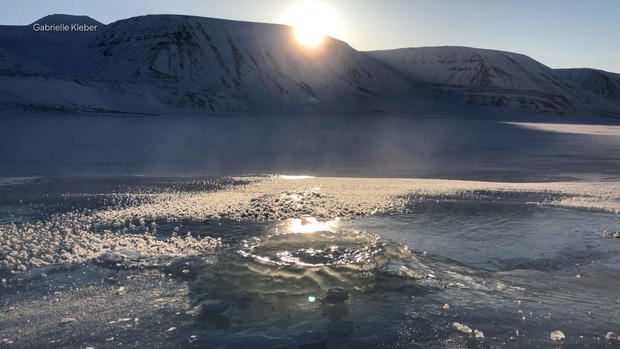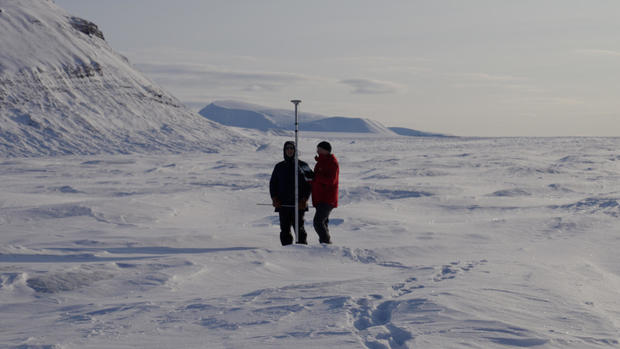Ancient methane escaping from melting glaciers could potentially warm the planet even more
As mighty glaciers melt in the Arctic, new research finds million-year-old methane gas trapped beneath the ice is surfacing, with a potential to further warm the planet.
"Glacial retreat is the big driver of gas escape here," said Andy Hodson, a glaciologist at the University Centre in Svalbard, Norway.
CBS News traveled to the world's northernmost and fastest-warming community of Svalbard, Norway. What scientists are learning there helps Americans understand the changes happening in the United States. As the Arctic warms, it adds to rising sea levels along our coasts and instability in the atmosphere that contributes to our extreme weather events.
Across Svalbard, a cluster of islands close to the North Pole, Hodson and his colleagues are detecting methane gas gurgling up through groundwater springs. As part of their research, they checked 123 springs. They found methane in all but one.
"What's escaping is quite modest, but what's down there is quite vast," Hodson said.
Budgeting for methane
Carbon dioxide emissions from cars and factories are the primary driver of climate change, and can stay in the atmosphere for hundreds of years. While methane is short-lived in the atmosphere, it is far better at trapping heat.
The primary sources of methane come from the production of fossil fuels and agriculture. More than 100 countries, including the U.S., have signed the Global Methane Pledge, which is a commitment to cut emissions 30% by 2030.
But Hodson is concerned the world's accounting of how much methane is emitted each year does not include the gas emerging from the Arctic.

"If there's a huge natural rush of methane about to come, then that will change our planning for methane management," he said. "It matters if we're going to commit to responsible methane management," he added.
Permafrost, a frozen blanket of soil, can lock massive amounts of ancient methane gas underground. As a glacier recedes, space can open at the edge of the permafrost, which then allows gas to escape.
Disappearing glaciers
And in Svalbard, the glaciers truly are vanishing.
"It's dramatic to see the changes from year to year," said Jack Kohler, an American glaciologist with the Norwegian Polar Institute, which advises the Norwegian government on changes in the Arctic.
Twice a year, Kohler visits a remote outpost called Ny Alesund, home to the world's northernmost research station. There, he measures a glacier called Kronebreen, one of the largest of Svalbard's 1,500 glaciers. In 30 years, he's observed Kronebreen receding by 2.5 miles.
"We're documenting the effect of the climate change locally here," Kohler said. "I have colleagues all over the globe who are doing similar things and they're all seeing the same thing," he added.
At the end of winter, Kohler pounds long, metal stakes into Kronebreen's ice to check the health of the glacier. He starts close to the glacier front and works his way up to where it starts.

In summer, after the warm air temperature melts the ice, he comes back to check the stakes. This September, the first stake he examined, which was previously hammered below the ice, was now exposed and showed 8 feet of melt.
"All glaciers lose their ice somehow," he said. "And as long as the loss is equal to what's going in at the top, then the geometry of the glacier will remain unchanged."
But that's not happening. Not only is Kronebreen retreating at the front, but Kohler's measurements also show the glacier is not building up enough new ice miles further up, where it begins.
Kohler said warmer summers in Svalbard mean the glaciers are now melting faster than they can be replenished in winter.
"The problem is when there's less winter precipitation up there, and then that large amount of melting, means that there's an overall loss," Kohler said, standing close to the face of the glacier.
Kohler and his colleagues modeled future melting conditions for Svalbard's glaciers. Overall, they concluded by 2100, the glaciers will be losing their ice twice as fast as they are now.
Take an adventure to Svalbard, Norway in this special interactive web page and learn how climate change is impacting communities across our country too.
Meet our experts
Jack Kohler is a glaciologist who has studied the disappearing glaciers of Svalbard for 27 years for the Norwegian Polar Institute. It's hard work. At the end of winter, Kohler lands on a glacier by helicopter to pound long stakes deep into the ice. Six months later, after the summer melting season, he returns to record how much of the stakes are now exposed. The more of a stake he can see, the more ice has been lost.
Andy Hodson is a methane hunter. As a professor of glaciology, he's documenting how ancient methane, trapped deep underground, is escaping at the edge of glaciers as they retreat. Hodson and his colleagues at the University Centre in Svalbard have measured 123 springs around Svalbard and found methane in all but one. Methane is a potent greenhouse gas that 150 countries, including the US, have pledged to cut. Hodson's concerned the methane he's finding will complicate that effort.
- In:
- Glacier
- Climate Change
- Norway
David Schechter is a national environmental correspondent and the host of "On the Dot with David Schechter," a guided journey to explore how we're changing the earth and earth is changing us.
Disclaimer: The copyright of this article belongs to the original author. Reposting this article is solely for the purpose of information dissemination and does not constitute any investment advice. If there is any infringement, please contact us immediately. We will make corrections or deletions as necessary. Thank you.
Title:Ancient methane escaping from melting glaciers could potentially warm the planet even more
Url:https://www.investsfocus.com









